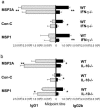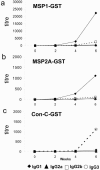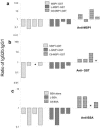Epitope-specific regulation of immunoglobulin class switching in mice immunized with malarial merozoite surface proteins
- PMID: 16299306
- PMCID: PMC1307071
- DOI: 10.1128/IAI.73.12.8119-8129.2005
Epitope-specific regulation of immunoglobulin class switching in mice immunized with malarial merozoite surface proteins
Abstract
Antibodies that bind to Fc receptors and activate complement are implicated in the efficient control of pathogens, but the processes that regulate their induction are still not well understood. To investigate antigen-dependent factors that regulate class switching, we have developed an in vivo model of class switching to immunoglobulin G2b (IgG2b) using the malaria antigen Plasmodium falciparum merozoite surface protein 2 (MSP2). C57BL/6 mice were immunized with recombinant proteins representing discrete domains of MSP2, and a T-cell epitope (C8) was identified within the conserved C terminus of the protein that preferentially induces IgG2b antibodies. The ability of C8 to induce IgG2b is ablated in both homozygous gamma interferon-negative and interleukin 10-negative mice. The IgG2b-inducing properties of C8 override the IgG1-inducing properties of both the fusion protein partner, glutathione S-transferase, and the adjuvant. Furthermore, when attached to other proteins that normally induce IgG1 responses, C8 induces a switch to IgG2b secretion. This is the first description of a defined T-cell epitope that drives specific IgG2b subclass switching, and our data offer proof of the concept that chimeric vaccines incorporating specific T-cell "switch epitopes" might be used to enhance qualitative aspects of the antibody response.
Figures






Similar articles
-
Strain-transcending immune response generated by chimeras of the malaria vaccine candidate merozoite surface protein 2.Sci Rep. 2016 Feb 11;6:20613. doi: 10.1038/srep20613. Sci Rep. 2016. PMID: 26865062 Free PMC article.
-
Cytokines and antibody subclass associated with protective immunity against blood-stage malaria in mice vaccinated with the C terminus of merozoite surface protein 1 plus a novel adjuvant.Infect Immun. 1996 Sep;64(9):3532-6. doi: 10.1128/iai.64.9.3532-3536.1996. Infect Immun. 1996. PMID: 8751895 Free PMC article.
-
Immunogenicity of a recombinant malaria vaccine candidate, domain I+II of AMA-1 ectodomain, from Indian P. falciparum alleles.Vaccine. 2008 Aug 18;26(35):4526-35. doi: 10.1016/j.vaccine.2008.06.031. Epub 2008 Jun 30. Vaccine. 2008. PMID: 18590786
-
Protection against Plasmodium chabaudi malaria induced by immunization with apical membrane antigen 1 and merozoite surface protein 1 in the absence of gamma interferon or interleukin-4.Infect Immun. 2004 Oct;72(10):5605-12. doi: 10.1128/IAI.72.10.5605-5612.2004. Infect Immun. 2004. PMID: 15385457 Free PMC article.
-
Linkage of exogenous T-cell epitopes to the 19-kilodalton region of Plasmodium yoelii merozoite surface protein 1 (MSP1(19)) can enhance protective immunity against malaria and modulate the immunoglobulin subclass response to MSP1(19).Infect Immun. 2000 Apr;68(4):2102-9. doi: 10.1128/IAI.68.4.2102-2109.2000. Infect Immun. 2000. PMID: 10722607 Free PMC article.
Cited by
-
Age-dependent changes in circulating Tfh cells influence development of functional malaria antibodies in children.Nat Commun. 2022 Jul 18;13(1):4159. doi: 10.1038/s41467-022-31880-6. Nat Commun. 2022. PMID: 35851033 Free PMC article.
-
A phase 1 trial of MSP2-C1, a blood-stage malaria vaccine containing 2 isoforms of MSP2 formulated with Montanide® ISA 720.PLoS One. 2011;6(9):e24413. doi: 10.1371/journal.pone.0024413. Epub 2011 Sep 19. PLoS One. 2011. PMID: 21949716 Free PMC article. Clinical Trial.
-
Target antigen, age, and duration of antigen exposure independently regulate immunoglobulin G subclass switching in malaria.Infect Immun. 2006 Jan;74(1):257-64. doi: 10.1128/IAI.74.1.257-264.2006. Infect Immun. 2006. PMID: 16368979 Free PMC article.
-
Nutrient Deficiencies and Potential Alteration in Plasma Levels of Naturally Acquired Malaria-Specific Antibody Responses in Tanzanian Children.Front Nutr. 2022 Jun 17;9:872710. doi: 10.3389/fnut.2022.872710. eCollection 2022. Front Nutr. 2022. PMID: 35782946 Free PMC article.
-
Assessment of humoral immune responses to blood-stage malaria antigens following ChAd63-MVA immunization, controlled human malaria infection and natural exposure.PLoS One. 2014 Sep 25;9(9):e107903. doi: 10.1371/journal.pone.0107903. eCollection 2014. PLoS One. 2014. PMID: 25254500 Free PMC article. Clinical Trial.
References
-
- Ahlborg, N., I. Ling, A. Holder, and E. Riley. 2000. Linkage of universal T-cell epitopes to the 19 kDa region of Plasmodium yoelii merozoite surface protein 1 (MSP119) can enhance protective immunity against malaria and modulates the IgG subclass response to MSP119. Infect. Immun. 68:2102-2109. - PMC - PubMed
-
- Bastian, M., J. M. Lozano, M. E. Patarroyo, G. Pluschke, and C. A. Daubenberger. 2004. Characterization of a reduced peptide bond analogue of a promiscuous CD4 T cell epitope derived from the Plasmodium falciparum malaria vaccine candidate merozoite surface protein 1. Mol. Immunol. 41:775-784. - PubMed
-
- Bouharoun-Tayoun, H., P. Attanath, A. Sabchareon, T. Chongsuphajaisiddhi, and P. Druilhe. 1990. Antibodies that protect humans against Plasmodium falciparum blood stages do not on their own inhibit parasite growth and invasion in vitro but act in co-operation with monocytes. J. Exp. Med. 172:1633-1641. - PMC - PubMed
-
- Boutlis, C. S., P. K. Fagan, D. C. Gowda, M. Lagog, C. S. Mgone, M. J. Bockarie, and N. M. Anstey. 2003. Immunoglobulin G (IgG) responses to Plasmodium falciparum glycosylphosphatidylinositols are short-lived and predominantly of the IgG3 subclass. J. Infect. Dis. 187:862-865. - PubMed
Publication types
MeSH terms
Substances
Grants and funding
LinkOut - more resources
Full Text Sources
Other Literature Sources
Molecular Biology Databases

